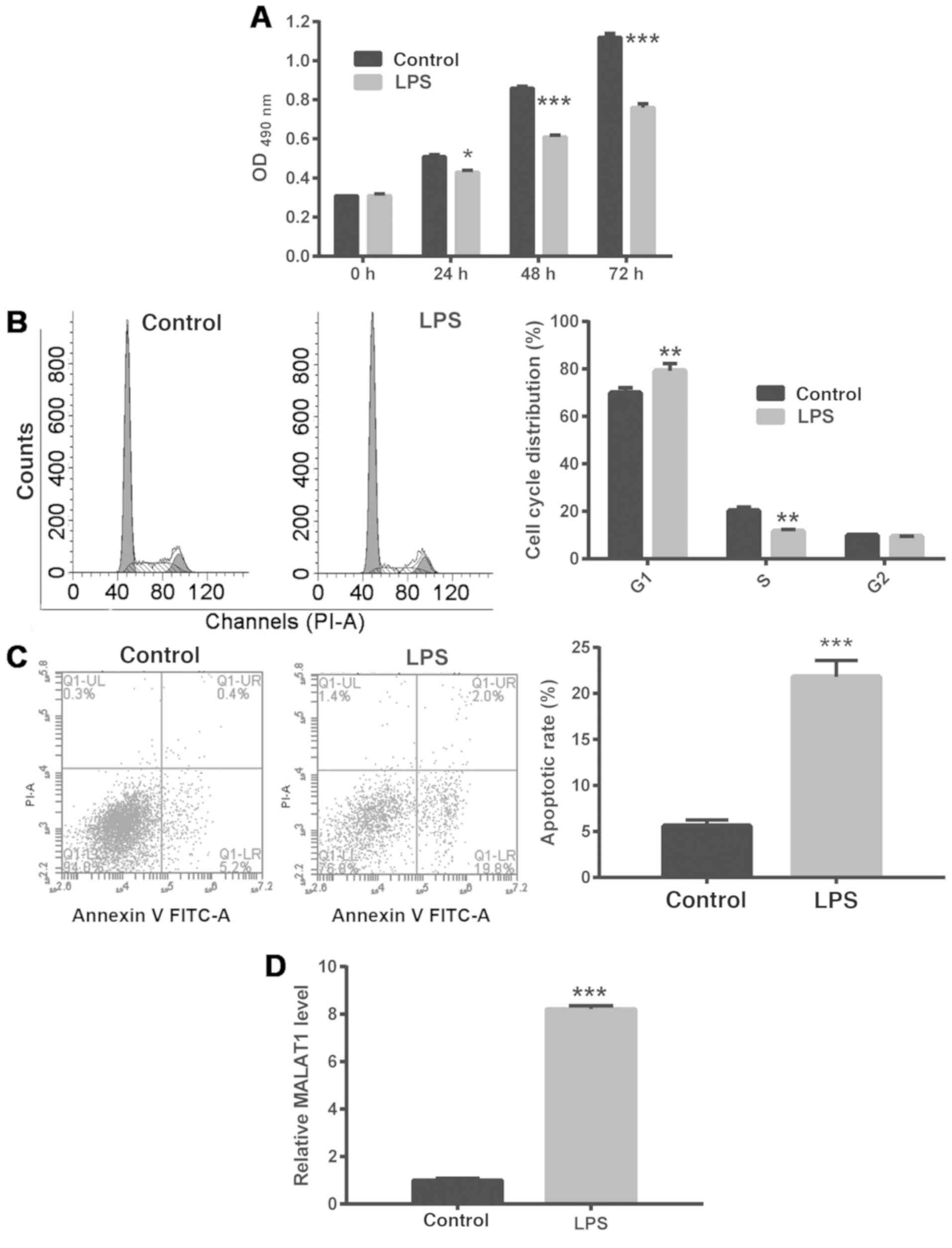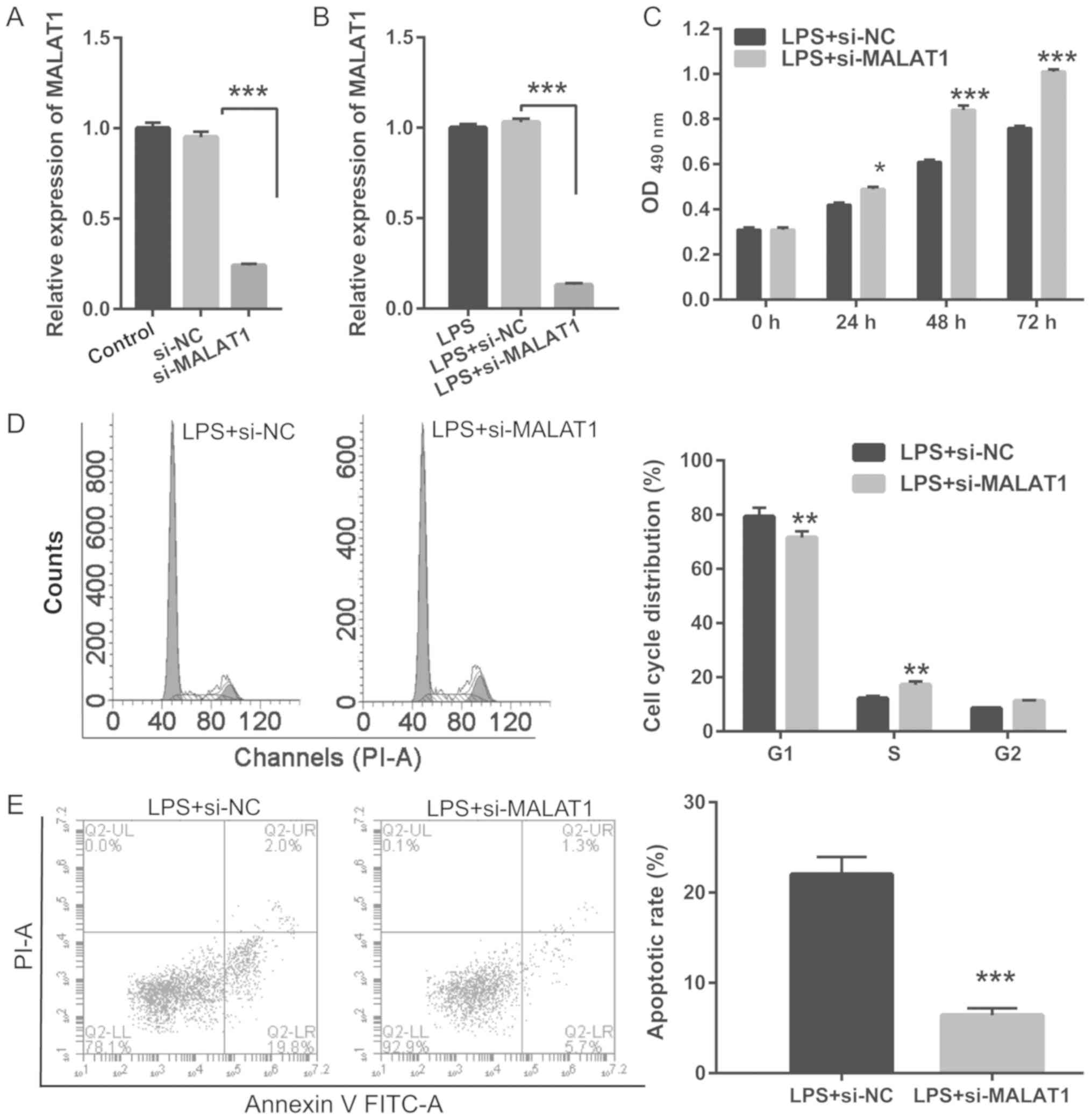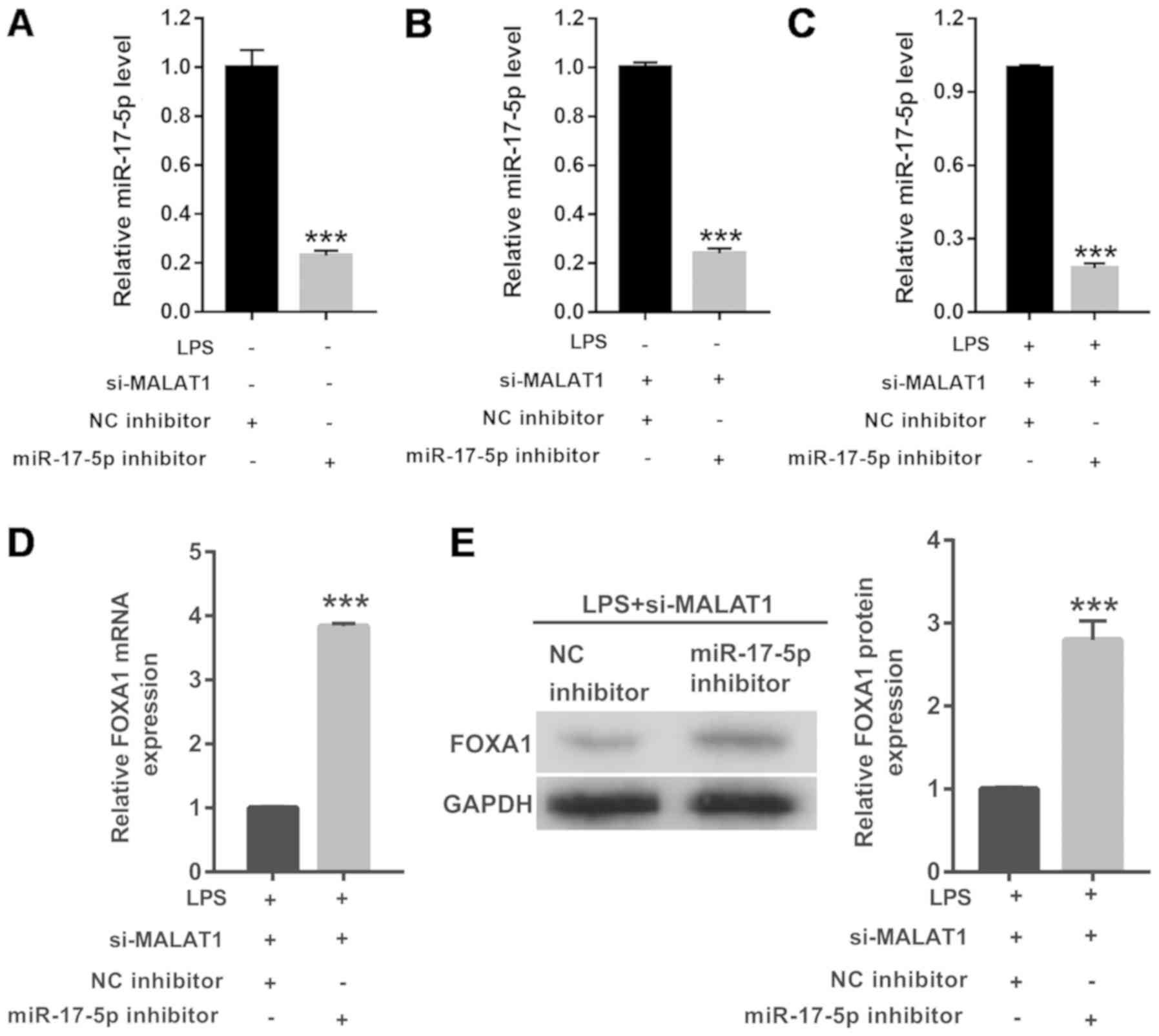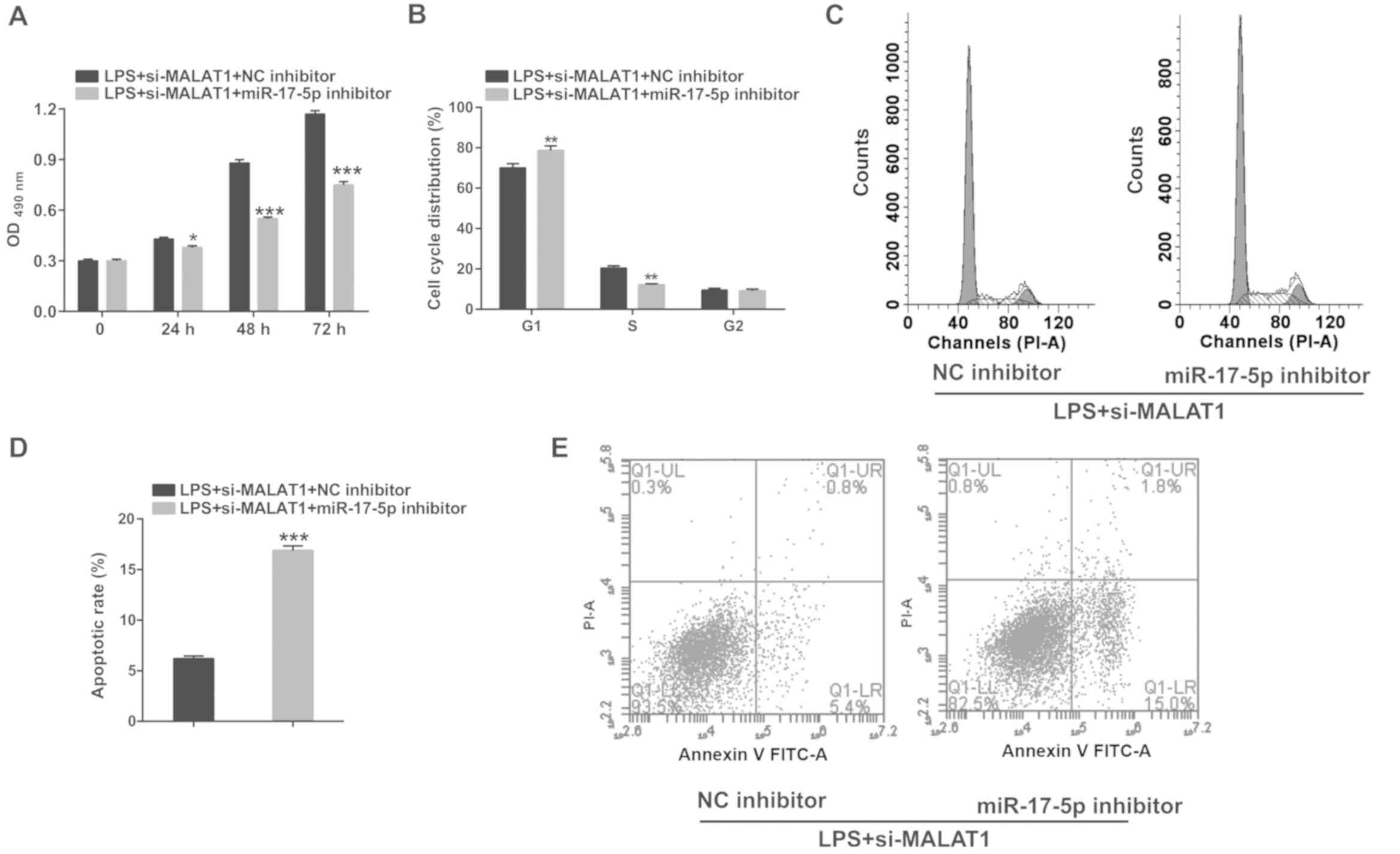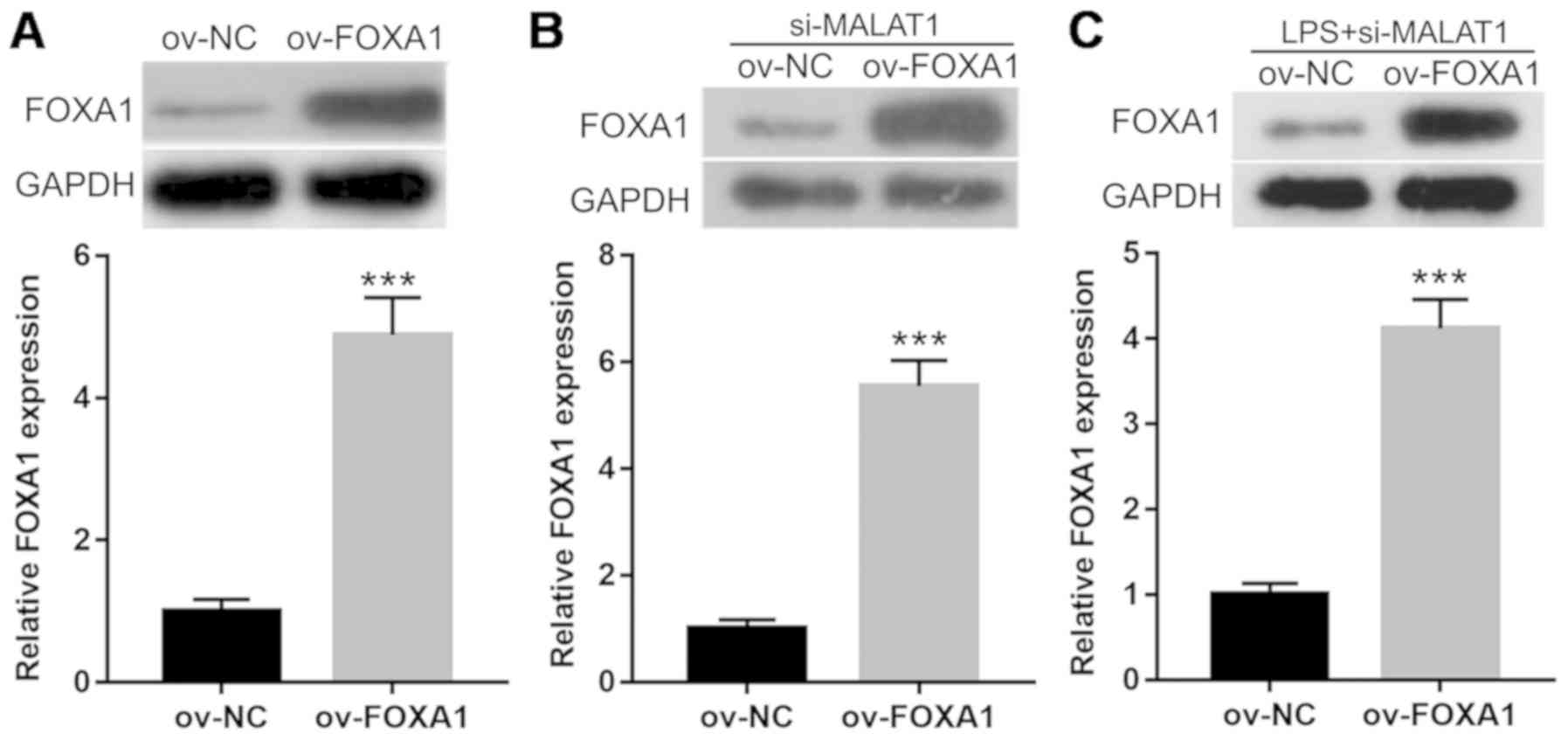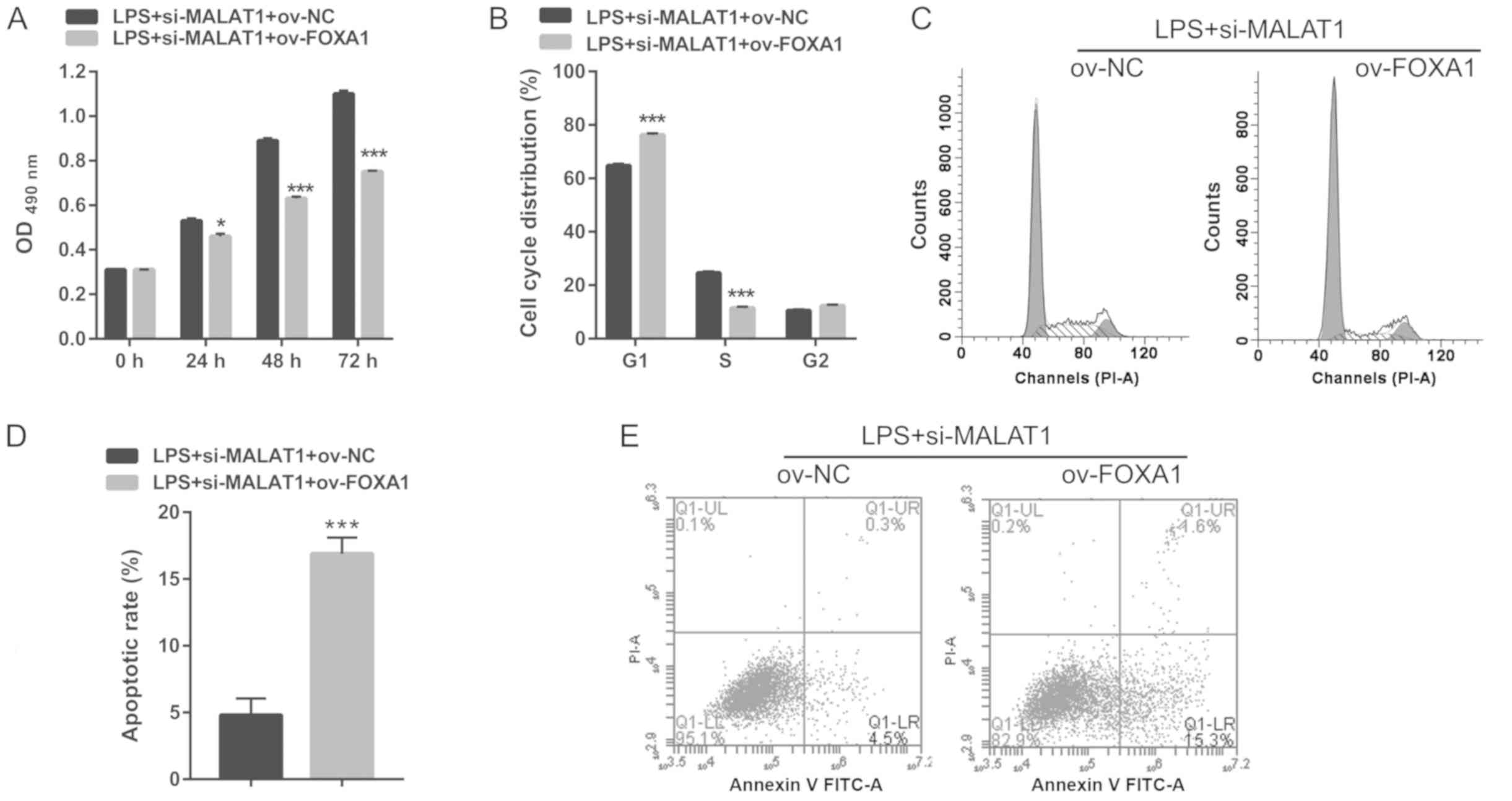Knockdown of the lncRNA MALAT1 alleviates lipopolysaccharide‑induced A549 cell injury by targeting the miR‑17‑5p/FOXA1 axis
- Authors:
- Published online on: June 18, 2019 https://doi.org/10.3892/mmr.2019.10392
- Pages: 2021-2029
Abstract
Introduction
Acute lung injury (ALI) and its severe form, acute respiratory distress syndrome, are serious and potentially life-threatening syndromes (1). Despite the tremendous advancement in the prevention and treatment of ALI, no effective therapeutic regimen is available, and the mortality rate remains as high as 40% (2). Therefore, it is important to improve understanding of the pathophysiology of ALI in order to develop effective strategies for its prevention and treatment.
Long-noncoding RNAs (lncRNAs) provide new insights into the pathogenesis of ALI, and may serve as novel therapeutic agents. Recent studies have reported that the lncRNAs lincRNA-p21, cancer susceptibility 2 and H19 imprinted maternally expressed transcript regulate lipopolysaccharide (LPS)-induced ALI (3–5). The lncRNA metastasis-associated lung adenocarcinoma transcript 1 (MALAT1) was first reported as a prognostic marker of metastasis in lung cancer (6). MALAT1 was found to be aberrantly expressed in high-glucose-induced podocyte injury (7) and LPS-induced acute kidney injury (8). In addition, MALAT1 was shown to suppress the inflammatory responses in LPS-induced ALI by regulating microRNA-146 (miRNA/miR-146a) (9). However, the mechanisms underlying the effects of MALAT1 on cell proliferation and apoptosis in LPS-induced ALI remain unclear.
LncRNAs act as competing endogenous RNAs (ceRNAs) and modulate the expression and biological functions of miRNAs (10). miRNAs such as miR-126-5p and miR-181a are central regulators involved in the pathogenesis of ALI (11,12). The expression of miR-17-5p was found to be inhibited in LPS-induced ALI, whereas miR-17-5p overexpression was shown to counteract the effects of LPS through the inhibition of forkhead box A1 (FOXA1) expression (13). FOXA1 is a member of the winged-helix family of transcription factors and shares structural similarities with FOXA2 and FOXA3. Song et al (14) reported that the overexpression of FOXA1 promoted pulmonary epithelial cell apoptosis in ALI. Whether MALAT1 acts as a ceRNA for the miR-17-5p/FOXA1 axis, consequently regulating cell proliferation and apoptosis, in LPS-induced A549, remains unclear.
In the present study, the expression of MALAT1 was evaluated in LPS-induced A549 cells and its role in cell proliferation, cell cycle progression and apoptosis was investigated. The regulatory action of MALAT1 in LPS-induced ALI was also explored.
Materials and methods
Cell culture and transfection
The A549 cell line was purchased from the Cell Bank of Type Culture Collection of Chinese Academy of Sciences. Cells were cultured in DMEM (Gibco; Thermo Fisher Scientific, Inc.) supplemented with 10% FBS (Gibco; Thermo Fisher Scientific, Inc.) and 1% penicillin-streptomycin. Cells were maintained at 37°C in a 5% CO2 atmosphere. The following small interfering RNAs (siRNAs) and miRNA inhibitors were purchased from Guangzhou RiboBio Co., Ltd.: si-MALAT1 (5′-CAAGCAGACAGCCCGTGCTGCTT-3′), si-negative control (si-NC; 5′-TTCTCCGAACGTGTCACGTTT-3′), miR-17-5p inhibitor (5′-GATGGACGTGACATTCGTGAAAC-3′) and negative control inhibitor (NC inhibitor; 5′-TTCTCCGAACGTGTCACGTTT-3′). The FOXA1-coding sequence including Xho1 and Xba 1 restriction sites was chemically synthesized by Genewiz, Inc. and cloned into pcDNA 3.1 (ov-FOXA1; Promega Corporation). The empty pcDNA 3.1 plasmid served as a negative control (ov-NC). A549 cell (2×105 cells/well) were transfected with 50 nM si-MALAT1, 50 nM si-NC, 50 nM miR-17-5p inhibitor, 50 nM NC inhibitor, 1 µg/µl ov-FOXA1 and/or 1 µg/µl ov-NC using 1 µl Lipofectamine® 2000 (Invitrogen; Thermo Fisher Scientific, Inc.), according to the manufacturer's instructions. At 48 h after transfection, cells were treated with 1 µg/ml LPS for 24 h. The concentration of LPS used was selected based on previous reports (13,15).
Reverse transcription-quantitative PCR (RT-qPCR)
Total RNA was isolated from cells using TRIzol reagent (Invitrogen; Thermo Fisher Scientific, Inc.) and subjected to RT using an ImProm-II™ Reverse Transcription System (Promega Corporation). The conditions of RT were 30°C for 10 min and 42°C for 60 min, followed by 85°C for 10 min. qPCR was performed using the SYBR® Premix ExTaq™ II kit (Takara Biotechnology Co., Ltd.) on a 7500 Real-Time PCR System (Applied Biosystems; Thermo Fisher Scientific, Inc.). qPCR thermocycling conditions were as follows: Denaturation at 95°C for 10 min, followed by 40 cycles at 95°C for 15 sec and 65°C for 32 sec. The relative expression levels of mRNA/lncRNA and miRNA were calculated using the 2−ΔΔCq method (16). GAPDH and U6 served as reference genes. The sequences of primers were as follows: MALAT1, forward 5′-GATAAATTTAAACCTGAAAA-3′ and reverse 5′-ATCTTGTTTCTATCTTCCAA-3′; miR-17-5p, forward 5′-ACACTCCAGCTGGGCAAAGTGCTTACAGTGC-3′ and reverse 5′-CTCAACTGGTGTCGTGGA-3′; FOXA1, forward 5′-CCTCTTCCCCTATTACCGGC-3′ and reverse 5′-GTCCGGGGAGCGTGCCACCT-3′; U6, forward 5′-CTCGCTTCGGCAGCACA-3′ and reverse 5′-AACGCTTCACGAATTTGCGT-;3 GAPDH, forward 5′-GCTCATTTGCAGGGGGGAG-3′ and reverse 5′-GTTGGTGGTGCAGGAGGCA-3′. All reactions were performed in triplicate.
Cell proliferation assay
Cell proliferation was assessed using the CellTiter 96® AQueous One Solution Cell Proliferation Assay (MTS, Promega). Briefly, transfected cells were seeded in three duplicates at a density of 1×104 cells/well in a 96-well plate in 100 µl culture medium containing 10% FBS and incubated for various time points (0, 24, 48 and 72 h) following 1 µg/ml LPS treatment. After incubation, 20 µl MTS was added to each well and the cells were incubated for 2 h at 37°C and 5% CO2 in the dark. The optical density at 490 nm was measured using a microplate absorbance reader.
Cell cycle analysis
Cell cycle assays were performed using the Cell Cycle Detection kit (Nanjing Keygen Biotech Co., Ltd.). Briefly, 1×106 cells were collected, rinsed twice with PBS and collected by centrifugation at 800 × g for 5 min at 4°C. The cell pellet was resuspended in ice-cold 70% ethanol and stored at 25°C for 2 h. The cells were collected by centrifugation at 800 × g for 5 min at 4°C, washed twice with cold PBS, and 100 µl RNase A was added to resuspend the cell pellet; the mixture was incubated at 37°C for 30 min. Subsequently, 400 µl propidium iodide (PI) was added and incubated at 4°C for 30 min in the dark. The PI signal was detected using a BD caliber flow cytometer (BD Biosciences). The population of cells in G1, S and G2 phases is expressed as the percentage of total gated cells which analyzed by FlowJo software (version 10.5.3, FlowJo LLC).
Apoptosis assay
Apoptotic cells were quantified using the Annexin V-FITC/PI Apoptosis Detection kit (Nanjing Keygen Biotech Co., Ltd.). Briefly, cells were harvested, washed twice with ice-cold PBS and resuspended in 500 µl binding buffer. The cells were then incubated with 5 µl Annexin V-FITC and 5 µl PI, incubated for 15–20 min in the dark at 25°C, and analyzed with FlowJo software using a BD FACSCalibur™ flow cytometer (BD Biosciences).
Western blot analysis
Cells were collected and lysed in RIPA buffer (Thermo Fisher Scientific, Inc.) supplemented with a protease inhibitor (Thermo Fisher Scientific, Inc.). The protein concentration was measured using a bicinchoninic acid protein assay kit (Thermo Fisher Scientific, Inc.). Equal amounts of total protein (20 µg) were separated by 10% SDS-PAGE and transferred onto a PVDF membrane. Membranes were blocked with PBS containing 10% non-fat dry milk overnight at 4°C. After blocking, the membranes were incubated with primary antibodies against FOXA1 (1:2,000; cat. no. sc-101058; Santa Cruz Biotechnology, Inc.) or GAPDH (1:5,000; cat. no. 97166; Cell Signaling Technology, Inc.) at 4°C overnight, washed three times and incubated with a horseradish peroxidase-conjugated secondary antibody (1:20,000; cat. no. 1036-05; SouthernBiotech) for 2 h at 25°C. Proteins were visualized using an ECL substrate kit (GE Healthcare) and an ECL detection system (GE Healthcare). Image-Pro Plus 6.0 software (Media Cybernetics, Inc.) was used to quantify relative protein densities. GAPDH was used as a loading control.
Luciferase reporter assay
miRNAs that interacted with the MALAT1 sequence were predicted by LncBase Predicted v.2 software (http://carolina.imis.athena-innovation.gr/diana_tools/web/index.php?r=lncbasev2%2Findex-predicted) (17) and miRcode version 11 (http://www.mircode.org/). The wild-type (WT) or mutant (MUT) MALAT1 containing the putative target site for miR-17-5p were chemically synthesized by Genewiz, Inc. and subcloned into the psiCHECK2 vector (Promega Corporation) to analyze the interaction between MALAT1 and miR-17-5p. miR-17-5p mimics or inhibitors were co-transfected with the psiCHECK2-WT-MALAT1 or MUT-MALAT1 vector. Luciferase activity was measured 48 h after transfection using the Dual-Luciferase Reporter Assay System (Promega Corporation), according to the manufacturer's instructions. The ratio of firefly luciferase to Renilla luciferase activity was calculated.
Statistical analysis
Statistical analyses were conducted using the SPSS version 19.0 (IBM Corp). Each experiment was replicated three times. Data are presented as the mean ± SD. Differences between two groups were assessed using the independent sample t-test. Multiple groups were compared using one-way ANOVA followed by Tukey's post-hoc test. P<0.05 was considered to indicate a statistically significant difference.
Results
LPS promotes MALAT1 expression and apoptosis, and inhibits the proliferation of A549 cells
To explore the molecular mechanism underlying ALI, A549 cells were treated with 1 µg/ml LPS to simulate ALI. It was found that LPS treatment of A549 cells significantly inhibited their proliferation, arrested them at the G1/S phase checkpoint and promoted apoptosis (Fig. 1A-C). In addition, treatment with 1 µg/ml LPS significantly enhanced MALAT1 expression in A549 cells (Fig. 1D).
Knockdown of MALAT1 reverses the LPS-induced effects on proliferation and apoptosis in A549 cells
To investigate the biological role of MALAT1 on proliferation and apoptosis in LPS-treated cells, A549 cells were transfected with si-MALAT1 for 48 h and treated with or without 1 µg/ml LPS for 24 h. RT-qPCR results revealed that MALAT1 expression was significant reduced in A549 cells transfected with si-MALAT1 compared with control cells, with or without 1 µg/ml LPS treatment (Fig. 2A and B). Knockdown of MALAT1 promoted the proliferation, G1/S phase transition and suppressed apoptosis in LPS-treated A549 cells (Fig. 2C-E). Thus, MALAT1 knockdown reversed the effects of LPS.
MALAT1 directly targets miR-17-5p to regulate FOXA1 expression in LPS-treated A549 cells
LncBase Predicted v.2 and miRcode analysis allowed for the identification of a putative miR-17-5p-binding site in the MALAT1 sequence (Fig. 3A). To determine if miR-17-5p is a direct target of MALAT1, a dual-luciferase reporter assay was performed. miR-17-5p overexpression significantly decreased the WT-MALAT1-associated luciferase activity, whereas miR-17-5p inhibition significantly increased the WT-MALAT1-associated luciferase activity. However, miR-17-5p overexpression or inhibition had no effect on the luciferase activity of MUT-MALAT1 (Fig. 3B). Furthermore, 1 µg/ml LPS treatment for 24 h significantly inhibited the expression of miR-17-5p (Fig. 3C) and promoted the expression of FOXA1 (Fig. 3D and E). MALAT1 knockdown significantly increased the expression levels of miR-17-5p (Fig. 3F) and decreased FOXA1 (Fig. 3G and H) in A549 cells after 24 h exposure to LPS. These findings indicated that MALAT1 knockdown reversed the LPS-induced effects on miR-17-5p and FOXA1 expression in A549 cells.
miR-17-5p inhibition reverses the effects of MALAT1 knockdown on proliferation, cell cycle progression and apoptosis in LPS-treated A549 cells
To further investigate the effects of MALAT1 on LPS-treated A549 cells, the action of miR-17-5p expression was suppressed using a specific inhibitor. RT-qPCR results revealed that miR-17-5p expression was significantly reduced in cells transfected with the miR-17-5p inhibitor compared with the NC inhibitor (Fig. 4A). RT-qPCR results also revealed that miR-17-5p expression was significantly reduced in cells co-transfected with si-MALAT1 and miR-17-5p inhibitor, compared with cells co-transfected with si-MALAT1 and NC inhibitor, in A549 cells treated with or without 1 µg/ml LPS (Fig. 4B and C). Both the mRNA and protein levels of FOXA1 were significantly increased by miR-17-5p inhibitor (Fig. 4D and E). miR-17-5p inhibition also significantly inhibited cell proliferation (Fig. 5A) and G1/S phase transition (Fig. 5B and C), and promoted apoptosis (Fig. 5D and E), thus reversing the effects of si-MALAT1 on the LPS-treated A549 cells.
FOXA1 overexpression reverses the effects of MALAT1 knockdown on proliferation, cell cycle progression and apoptosis in LPS-treated A549 cells
A549 cells were co-transfected with si-MALAT1 and ov-FOXA1 for 48 h, and then treated with 1 µg/ml LPS for 24 h to investigate the effect of FOXA1 on MALAT1 expression. Western blot analysis showed that the protein expression levels of FOXA1 were significantly increased in cells transfected with ov-FOXA1 compared with those transfected with ov-NC (Fig. 6A). Results from western blotting analysis also showed that the protein expression levels of FOXA1 significantly increased in A549 cells co-transfected with si-MALAT1 and ov-FOXA1, compared with those co-transfected with si-MALAT1 and ov-NC, in cells with or without 1 µg/ml LPS treatment (Fig. 6B and C). Furthermore, FOXA1 overexpression significantly inhibited cell proliferation (Fig. 7A) and G1/S phase transition (Fig. 7B and C), and promoted apoptosis (Fig. 7D and E), thus reversing the effects of si-MALAT1 on LPS-treated A549 cells.
Discussion
LncRNAs have an important role in the pathophysiology of various human diseases, including ALI (18). MALAT1 is known to modulate inflammatory responses via miR-146a in LPS-induced ALI (9). However, the molecular mechanism underlying the MALAT1-mediated regulation of cell proliferation and apoptosis in this disease remains unclear. In the present study, it was found that LPS treatment markedly upregulated the expression of MALAT1, suppressed proliferation, and promoted cell cycle arrest and apoptosis in A549 cells. MALAT1 knockdown reversed these effects. In addition, miR-17-5p as identified as a direct target of MALAT1. The knockdown of miR-17-5p reversed the effects of MALAT1-mediated suppression on proliferation, cell cycle progression and apoptosis in LPS-treated A549 cells. These data revealed that the MALAT1/miR-17-5p/FOXA1 axis underlies LPS-induced A549 cell injury.
MALAT1 has an important role in cell proliferation and apoptosis. Previous studies have revealed that the upregulation of MALAT1 in LPS-treated cells inhibits cell proliferation, and promotes apoptosis and proinflammatory cytokine expression, in acute kidney injury and neonatal respiratory distress syndrome (8,19). Dai et al (9) revealed that MALAT1 expression was upregulated in the lung tissues of LPS-induced ALI rats and that the knockdown of MALAT1 attenuated this inflammatory response. Li et al (20) reported that suppression of MALAT1 expression alleviates ALI. Consistent with these findings, the present study observed that LPS treatment upregulated MALAT1 expression, suppressed proliferation and promoted apoptosis in A549 cells. Moreover, MALAT1 knockdown promoted cell proliferation and G1/S phase transition, and inhibited apoptosis of LPS-treated A549 cells. These results showed that the knockdown of MALAT1 alleviated LPS-induced A549 cell injury through the restoration of cell proliferation and prevention of apoptosis. These findings, along with those reported by Dai et al (9), demonstrate the regulatory function of MALAT1 in multiple processes of ALI, including proliferation, cell cycle progression, apoptosis and inflammatory responses.
MALAT1 serves as an endogenous miRNA sponge and negatively regulates miRNA expression. Previous studies have demonstrated that MALAT1 functions as a ceRNA by sequestering miR-19b, miR-199b and miR-146a to regulate LPS-induced murine chondrogenic cell inflammatory injury, acute spinal cord injury, and LPS-induced acute kidney injury, respectively (8,21,22). Dai et al (9) found that MALAT1 knockdown attenuated inflammatory responses by sequestering miR-146a in ALI. In the present study, miR-17-5p was identified as a novel potential target of MALAT1 by bioinformatic analyses. The results of a luciferase reporter assay demonstrated the direct interaction between MALAT1 and miR-17-5p, indicating that miR-17-5p is a direct target of MALAT1. A previous study reported a marked increase in the expression of miR-17-5p in LPS-induced nasal epithelial cells, which was related to the SMAD7-dependent increase in the severity of LPS-induced nasal epithelial cell injury (23). miR-17-5p downregulation causes FOXA1 overexpression and promoted alveolar type II epithelial cell apoptosis in LPS-induced ALI (13). Song et al (14) found an increase in the expression of FOXA1 in lung tissues, wherein it serves as a proapoptotic transcription factor. Furthermore, miR-17-5p could also target FOXA1 to inhibit apoptosis in LPS-induced ALI. In the present study, it was found that miR-17-5p expression was downregulated and FOXA1 expression was upregulated in LPS-treated A549 cells, consistent with the results of a previous report (13). Moreover, the knockdown of MALAT1 increased the expression level of miR-17-5p and inhibited the expression of FOXA1, whereas the simultaneous suppression of MALAT1 and miR-17-5p promoted FOXA1 expression. These results indicated that MALAT1 functions as a sponge for miR-17-5p and regulates FOXA1 expression. miR-17-5p inhibitor or FOXA1 overexpression reversed the effects of si-MALAT1 on proliferation, cell cycle progression and apoptosis of LPS-treated A549 cells. Thus, the knockdown of MALAT1 promoted cell proliferation and inhibited apoptosis through the upregulation of miR-17-5p, and downregulation of FOXA1, in LPS-induced ALI. The results of the present study and those of Dai et al (9) showed that MALAT1 regulates cell proliferation, cell cycle progression, apoptosis and inflammation based on its miRNA sequestering activity.
In conclusion, the present study demonstrated that the knockdown of MALAT1 alleviates LPS-induced injury in A549 cells by targeting the miR-17-5p/FOXA1 axis. These findings suggested that MALAT1 plays an important role in LPS-induced injury in A549 cells and may serve as a novel therapeutic target. Further studies are warranted to evaluate the role of MALAT1 in vivo and verify the impact of MALAT1 suppression on ALI pathogenesis.
Acknowledgements
Not applicable.
Funding
The present study was supported by the Medical Scientific Research Foundation of Guangdong Province, China (grant no. A2015385).
Availability of data and materials
Datasets analyzed during the present study are available from the corresponding author on reasonable request.
Authors' contributions
SW and ZiZ conceived and designed the present study, and developed the methodology. SW, KW and XH performed the experiments and collected the data. SW, WT and ZhZ analyzed and interpreted the data. SW and ZiZ drafted the manuscript. All authors read and approved the final manuscript.
Ethics approval and consent to participate
Not applicable.
Patient consent for publication
Not applicable.
Competing interests
The authors declare that they have no competing interests.
References
|
Mokra D and Kosutova P: Biomarkers in acute lung injury. Respir Physiol Neurobiol. 209:52–58. 2015. View Article : Google Scholar : PubMed/NCBI | |
|
Villar J, Sulemanji D and Kacmarek RM: The acute respiratory distress syndrome: Incidence and mortality, has it changed? Curr Opin Crit Care. 20:3–9. 2014. View Article : Google Scholar : PubMed/NCBI | |
|
Li H, Shi H, Gao M, Ma N and Sun R: Long non-coding RNA CASC2 improved acute lung injury by regulating miR-144-3p/AQP1 axis to reduce lung epithelial cell apoptosis. Cell Biosci. 8:152018. View Article : Google Scholar : PubMed/NCBI | |
|
Wu L, Sun L, Hua Y, Yang C and Teng Y: Overexpression of long non-coding RNA H19 protects lung fibroblasts from LPS-induced injury by targeting miR-181a and Runx2 via activation of Notch and JNK pathways. J Cell Biochem. Jan 8–2018.(Epub ahead of print). | |
|
Zhou WQ, Wang P, Shao QP and Wang J: Lipopolysaccharide promotes pulmonary fibrosis in acute respiratory distress syndrome (ARDS) via lincRNA-p21 induced inhibition of Thy-1 expression. Mol Cell Biochem. 419:19–28. 2016. View Article : Google Scholar : PubMed/NCBI | |
|
Gutschner T, Hämmerle M, Eissmann M, Hsu J, Kim Y, Hung G, Revenko A, Arun G, Stentrup M, Gross M, et al: The noncoding RNA MALAT1 is a critical regulator of the metastasis phenotype of lung cancer cells. Cancer Res. 73:1180–1189. 2013. View Article : Google Scholar : PubMed/NCBI | |
|
Hu M, Wang R, Li X, Fan M, Lin J, Zhen J, Chen L and Lv Z: LncRNA MALAT1 is dysregulated in diabetic nephropathy and involved in high glucose-induced podocyte injury via its interplay with β-catenin. J Cell Mol Med. 21:2732–2747. 2017. View Article : Google Scholar : PubMed/NCBI | |
|
Ding Y, Guo F, Zhu T, Li J, Gu D, Jiang W, Lu Y and Zhou D: Mechanism of long non-coding RNA MALAT1 in lipopolysaccharide-induced acute kidney injury is mediated by the miR-146a/NF-κB signaling pathway. Int J Mol Med. 41:446–454. 2018.PubMed/NCBI | |
|
Dai L, Zhang G, Cheng Z, Wang X, Jia L, Jing X, Wang H, Zhang R, Liu M, Jiang T, et al: Knockdown of LncRNA MALAT1 contributes to the suppression of inflammatory responses by up-regulating miR-146a in LPS-induced acute lung injury. Connect Tissue Res. 59:581–592. 2018. View Article : Google Scholar : PubMed/NCBI | |
|
Denzler R, Agarwal V, Stefano J, Bartel DP and Stoffel M: Assessing the ceRNA hypothesis with quantitative measurements of miRNA and target abundance. Mol Cell. 54:766–776. 2014. View Article : Google Scholar : PubMed/NCBI | |
|
Tang R, Pei L, Bai T and Wang J: Down-regulation of microRNA-126-5p contributes to overexpression of VEGFA in lipopolysaccharide-induced acute lung injury. Biotechnol Lett. 38:1277–1284. 2016. View Article : Google Scholar : PubMed/NCBI | |
|
Li W, Qiu X, Jiang H, Han Y, Wei D and Liu J: Downregulation of miR-181a protects mice from LPS-induced acute lung injury by targeting Bcl-2. Biomed Pharmacother. 84:1375–1382. 2016. View Article : Google Scholar : PubMed/NCBI | |
|
Xu Z, Zhang C, Cheng L, Hu M, Tao H and Song L: The microRNA miR-17 regulates lung FoxA1 expression during lipopolysaccharide-induced acute lung injury. Biochem Biophys Res Commun. 445:48–53. 2014. View Article : Google Scholar : PubMed/NCBI | |
|
Song L, Zhang B, Feng Y, Luo X, Wei X and Xiao X: A role for forkhead box A1 in acute lung injury. Inflammation. 32:322–332. 2009. View Article : Google Scholar : PubMed/NCBI | |
|
Luo Y, Che W and Zhao M: Ulinastatin post-treatment attenuates lipopolysaccharide-induced acute lung injury in rats and human alveolar epithelial cells. Int J Mol Med. 39:297–306. 2017. View Article : Google Scholar : PubMed/NCBI | |
|
Livak KJ and Schmittgen TD: Analysis of relative gene expression data using real-time quantitative PCR and the 2(-Delta Delta C(T)) method. Methods. 25:402–408. 2001. View Article : Google Scholar : PubMed/NCBI | |
|
Paraskevopoulou MD, Vlachos IS, Karagkouni D, Georgakilas G, Kanellos I, Vergoulis T, Zagganas K, Tsanakas P, Floros E, Dalamagas T and Hatzigeorgiou AG: DIANA-LncBase v2: Indexing microRNA targets on non-coding transcripts. Nucleic Acids Res. 44(D1): D231–D238. 2016. View Article : Google Scholar : PubMed/NCBI | |
|
Bolha L, Ravnik-Glavač M and Glavač D: Long noncoding RNAs as biomarkers in cancer. Dis Markers. 2017:72439682017. View Article : Google Scholar : PubMed/NCBI | |
|
Juan C, Wang Q, Mao Y, Cao Q, Li S, Qiao C, Zhang D and Zhou G: Knockdown of LncRNA MALAT1 contributes to cell apoptosis via regulating NF-κB/CD80 axis in neonatal respiratory distress syndrome. Int J Biochem Cell Biol. 104:138–148. 2018. View Article : Google Scholar : PubMed/NCBI | |
|
Li H, Shi H, Ma N, Zi P, Liu Q and Sun R: BML-111 alleviates acute lung injury through regulating the expression of lncRNA MALAT1. Arch Biochem Biophys. 649:15–21. 2018. View Article : Google Scholar : PubMed/NCBI | |
|
Pan L, Liu D, Zhao L, Wang L, Xin M and Li X: Long noncoding RNA MALAT1 alleviates lipopolysaccharide-induced inflammatory injury by upregulating microRNA-19b in murine chondrogenic ATDC5 cells. J Cell Biochem. 119:10165–10175. 2018. View Article : Google Scholar : PubMed/NCBI | |
|
Zhou HJ, Wang LQ, Wang DB, Yu JB, Zhu Y, Xu QS, Zheng XJ and Zhan RY: Long noncoding RNA MALAT1 contributes to inflammatory response of microglia following spinal cord injury via the modulation of a miR-199b/IKKβ/NF-κB signaling pathway. Am J Physiol Cell Physiol. 315:C52–C61. 2018. View Article : Google Scholar : PubMed/NCBI | |
|
Huang N, Li W, Wang X and Qi S: MicroRNA-17-5p aggravates lipopolysaccharide-induced injury in nasal epithelial cells by targeting Smad7. BMC Cell Biol. 19:12018. View Article : Google Scholar : PubMed/NCBI |



